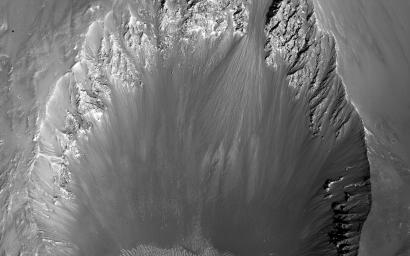On the Shape of Impact Craters
Caption:

Map Projected Browse Image
Click on the image for larger version
The shape of a crater can depend on factors including the angle of impact and the pre-impact slope and topography.
This
image shows a roughly 3-kilometer impact crater
, formed on the sloping walls of Tithonium Chasma, part of the large Valles Marineris canyon system. We can see that this crater is non-circular, measuring about 3 by 4 kilometers. The ejecta -- the debris that is generated and thrown out by an impact -- will typically distribute itself evenly around the outside of the crater rim where the pre-impact surface is flat and the angle of impact is not too low. However, due to the highly inclined nature of the surface here, the ejecta deposited preferentially downslope,
forming a tongue-like deposit
.
Additionally, when examining the area around the crater, we see smooth, dark-toned flow-like features superimposed on the ejecta blanket and
flowing downslope
. These are believed to be composed of impact -- or the mixture of rock and other material that melted upon impact -- and flowed down the slope before hardening. These potential impact melt deposits also occur as smooth ponds, which pooled on the surface of a portion of the ejecta that did not escape the crater interior.
Background Info:
The University of Arizona, Tucson, operates HiRISE, which was built by Ball Aerospace & Technologies Corp., Boulder, Colo. NASA's Jet Propulsion Laboratory, a division of the California Institute of Technology in Pasadena, manages the Mars Reconnaissance Orbiter Project for NASA's Science Mission Directorate, Washington.
Cataloging Keywords:
| Name |
Value |
Additional Values |
| Target |
Mars |
|
| System |
|
|
| Target Type |
Planet |
|
| Mission |
Mars Reconnaissance Orbiter (MRO) |
Mariner |
| Instrument Host |
Mars Reconnaissance Orbiter |
|
| Host Type |
Orbiter |
Flyby Spacecraft |
| Instrument |
High Resolution Imaging Science Experiment (HiRISE) |
|
| Detector |
|
|
| Extra Keywords |
Crater, Grayscale, Impact, Map |
| Acquisition Date |
|
| Release Date |
2016-05-18 |
| Date in Caption |
|
|
| Image Credit |
NASA/JPL-Caltech/Univ. of Arizona |
| Source |
photojournal.jpl.nasa.gov/catalog/PIA20587 |
| Identifier |
PIA20587 |

 Planetary Data System
Planetary Data System

